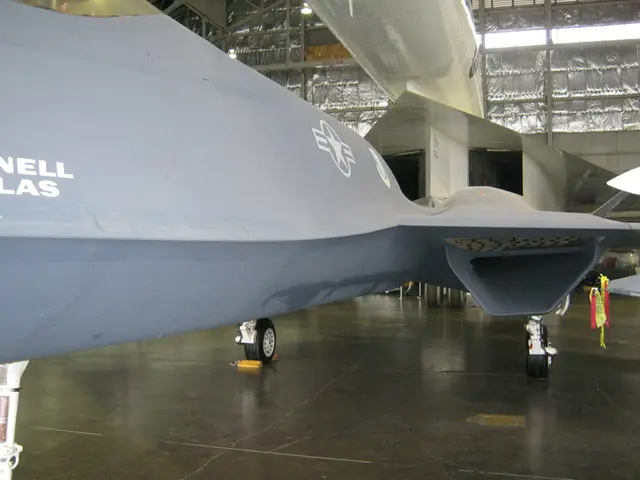Electric Vehicle Minitruck Variation of Ford's Model T, a Proposed Tesla Innovation: An Alternative Path Tesla Could Have Pursued
Ford Motor Company has unveiled its latest innovation, the Universal EV Platform, designed to revolutionise the electric vehicle (EV) market and compete directly with industry leaders such as Tesla and Chinese manufacturer BYD. The platform, announced during a livestream on August 11, 2025, promises significant cost and manufacturing efficiencies, with a focus on affordability and driving enjoyment.
The platform incorporates a number of innovative features, including a 20% reduction in parts, fewer fasteners, and shorter assembly times. Additionally, Ford has opted for lithium iron phosphate (LFP) prismatic batteries, which serve structurally as the vehicle floor, lowering the center of gravity, improving handling, and increasing interior space while cutting costs and enhancing durability.
In terms of pricing, the new platform is more expensive than BYD's Shark mini-truck, priced at $9,200 in China. However, the vehicles built on this platform, such as a new midsize electric truck launching in 2027, are targeting a price point around $30,000, offering features competitive with existing models like Tesla’s Model Y, but with a lower cost of ownership over five years.
Ford's innovation strategy involves a focus on radical cost reductions while maintaining quality and customer delight, aiming to compete head-on with Tesla’s lower-cost EVs. The company is also licensing LFP battery technology from China-based Contemporary Amperex Technology Co. Ltd. (CATL), reflecting the importance of Chinese tech in their supply chains.
However, the new platform has been criticised for not functioning like a traditional Skunkworks project, with major decisions allegedly approved by Ford's CEO, Jim Farley. Some have also suggested that the platform lacks imagination and innovation, and fails to bring the cost down to the $15,000 mark.
Despite these criticisms, Ford's CEO Jim Farley announced that the new platform would support a battery EV (BEV) minitruck, and Doug Field, Chief EV, Digital and Design Officer at Ford Motor Co., stated during the livestream that the new platform is a result of "brilliant minds taking fundamentally new approaches to old problems".
The new minitruck platform includes a "frunk" (front trunk), a feature that was also adopted by Ford's electric vehicle, the Lightning, from Tesla. The platform's skateboard design produces a flat floor, but the article suggests ditching the frunk to optimise passenger and cargo space.
Ford is investing $2B in the local economy and an additional $3B in a lithium-iron-phosphate (LFP) EV-battery factory in Marshall Michigan, creating 1,700 jobs. The new minitruck platform, available in 2027, will also include features such as unicastings using IDRA's high tonnage press technology, zonal wiring strategy, multiple body types on a common "skateboard", Ford's BlueCruise ADAS, mobile power-plant capability (V2H, V2G), and the claim of "The best part is no part".
As the EV market continues to evolve, Ford's Universal EV Platform represents a significant step forward in the company's efforts to compete with industry leaders and offer affordable electric vehicles to a wider market.
[1] Electronic Design Today newsletter [2] Andy's Automotive Electronics bi-weekly newsletter [3] Andy's Nonlinearities blog [4] BYD unveils Shark mini-truck priced at $7,000 to $9,200 in China [5] Ford invests $2B in Michigan, $3B in LFP battery factory, creating 1,700 jobs
- The University EV Platform introduced by Ford Motor Company, designed to revolutionize the electric vehicle market, incorporates innovative features like a 20% reduction in parts and a focus on lithium iron phosphate batteries.
- Although priced higher than BYD's Shark mini-truck, vehicles built on Ford's new platform, such as the upcoming midsize electric truck, target a competitive price point of around $30,000, offering features akin to Tesla's Model Y with a lower cost of ownership over five years.
- In a bid to compete directly with Tesla, Ford is licensing LFP battery technology from Contemporary Amperex Technology Co. Ltd. (CATL) and investing heavily in a lithium-iron-phosphate (LFP) EV-battery factory, demonstrating the importance of Chinese tech in their supply chains.
- Despite criticism for not adopting a traditional Skunkworks project approach and lacking innovation in certain aspects, Ford CEO Jim Farley announced plans to support a battery EV (BEV) minitruck and emphasized the platform's foundation in "brilliant minds taking fundamentally new approaches to old problems."
- Ford is investing $2B in Michigan's local economy and an additional $3B in an LFP EV-battery factory, creating 1,700 jobs and offering features such as BlueCruise ADAS, mobile power-plant capability, and the claim of "The best part is no part" on their new minitruck platform launching in 2027.




